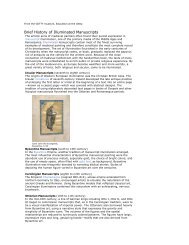Download File - ProfGracie
Download File - ProfGracie
Download File - ProfGracie
You also want an ePaper? Increase the reach of your titles
YUMPU automatically turns print PDFs into web optimized ePapers that Google loves.
Chapter 18 and 19
Chapter 18<br />
Intl. Typographic Style
Visual Characteristics<br />
• Visual Unity achieved through<br />
asymmetrical organization<br />
• Objective photography<br />
• San-serif typography, ragged-right<br />
justification
Social Characteristics<br />
• Design is useful and an important<br />
activity<br />
• Personal expression was not as<br />
important as message<br />
• Achieving clarity and organization is<br />
the ideal
Max Bill<br />
“It is possible to develop art largely on<br />
the basis of mathematical thinking.”<br />
Max Bill, 1949
Semiotics<br />
The general philosophical theory of signs<br />
and symbols.<br />
Three branches of semiotics: 1.<br />
Semantics, 2. Syntactics, 3. Pragmatics
Semantics - Semiotics<br />
The study of the meaning of signs and<br />
symbols.
Syntactics - Semiotics<br />
The study of HOW signs and symbols are<br />
connected and ordered into a structured<br />
whole.
Pragmatic - Semiotics<br />
The study of the relationship between<br />
the signs and symbols and the viewer.
Important Typefaces<br />
Adrian Frutiger<br />
Univers<br />
Helvetica<br />
Herman Zaph<br />
Palatino, Melior, Optima
Intl. Typographic Style<br />
in America<br />
1960s and 1970s<br />
Rudolph DeHarak: continuing quest for<br />
communicative clarity and visual order.<br />
DeHarak designed book covers for<br />
McGraw Hill Pub., Album covers for<br />
Westminster Records
Rudolph DeHarak
Chapter 19
The New York School<br />
Many Immigrants contributed to the 2nd<br />
half of 20th century design in America.<br />
American Design was less formal than<br />
the structured design of Europe.<br />
American was more flexible in the<br />
approach to organization of space.
New York School<br />
Pioneers<br />
• Paul Rand - 1914 - 1996<br />
• Paul Rand of the Weintraub<br />
advertising agency.<br />
• Stafford, Goodman & Theise<br />
Ad<br />
• One in a series of ads for<br />
Stafford, Goodman &<br />
Theise, Inc.
Other New York School<br />
Pioneers<br />
• Bradbury Thompson<br />
• Saul Bass<br />
• Ivan Chermayeff<br />
• Thomas Geismar
Bradbury Thompson<br />
Emerged as one of the<br />
most influential graphic<br />
designers of postwar<br />
America.<br />
Worked for printing<br />
forms in Kansas before<br />
moving to New York.<br />
Very adventurist spririt<br />
that he infused into his<br />
designs.
Saul Bass<br />
• Saul Bass<br />
Movie Poster<br />
• Brought NY<br />
School to Los<br />
Angeles and the<br />
movie industry
Brownjohn, Chermayeff<br />
& Geismar<br />
• Called their firm a<br />
“Design Office” not a<br />
studio.<br />
• Their work<br />
characterized by<br />
communicative<br />
immediacy, strong<br />
sense of form and a<br />
vitality that was<br />
refreshing.
Thomas Geismar<br />
•Thomas H. Geismar, cover<br />
for Common Sense and<br />
Nuclear Warfare, 1958<br />
•In the cover for Common<br />
Sense and Nuclear<br />
Warfare, the atomic blast<br />
becomes a visual<br />
metaphor for the human<br />
brain, graphically echoing<br />
the title.
Cipe Pineles<br />
• Art director and designer<br />
• Made major contributions<br />
to editorial design during<br />
the 1940s and 1950s.<br />
• Best known for cover<br />
designs for Seventeen,<br />
Glamour, Harper’s<br />
Bazaar, Charm, and<br />
Vogue.
Cipe Pineles<br />
• Art director and designer<br />
• Made major contributions to<br />
editorial design during the 1940s<br />
and 1950s.<br />
• Best known for cover designs for<br />
Seventeen, Glamour, Harper’s<br />
Bazaar, Charm, and Vogue.
Henry Wolf<br />
• Simple images convey a<br />
visual idea such as<br />
covers for Esquire,<br />
Harper’s Bazaar.<br />
• Achieved a high<br />
aesthetic level of layout<br />
and photography.
Typography Design<br />
• Herb Lubalin (1918 - 1981) was<br />
hailed as “the typographic<br />
genius of his time”.<br />
• He practiced design not as an<br />
art form but as a means of<br />
giving visual form to a concept<br />
or a message. In his most<br />
innovative work, concept and<br />
visual forms are put into a<br />
oneness called typogram,<br />
meaning a brief, visual<br />
typographic poem.
Avant - Garde<br />
• Avant - Garde magazine was born<br />
amidst the social upheavals of civil<br />
rights, women’s liberation, the sexual<br />
revolution and antiwar protests.<br />
• Art with tightly integrated ligatures<br />
within the type faces.<br />
• One of Lubalin’s most crowning<br />
achievements.<br />
• Layouts have a strong underlying<br />
geometric structure.
George Lois<br />
• Worked for Doyle Dane Bernbach, an advertising agency that opened in<br />
NYC in 1949 and that set a new standard of design excellence and<br />
energy into an otherwise lackluster period of time,<br />
• Designs are deceptively simple and single mindedly direct.<br />
Backgrounds are usually stripped away to enable the content<br />
bearing verbal and pictorial images to interact unhampered, a<br />
technique he learned at Bernbach
George Lois<br />
Lean Cuisine is one of the most recognizable brand today.<br />
Mickey Mantle, Wilt Chamberlain, Don<br />
Meredith (pictured), Johnny Unitas and<br />
many other "grown men" were shown<br />
crying out "I Want My Maypo" in the<br />
famous campaign changing the mindset of<br />
the famous cereal in the 1960's.(photo<br />
courtesy of Sellebrity-Lois 2003)
Conclusion<br />
• The New York School was born from an excitement<br />
about European modernism and fueled by economic<br />
technological expansion.<br />
• It became the dominant force in graphic design from<br />
1940 - 1970<br />
• Many of the original designers designed well into the<br />
1990s.




